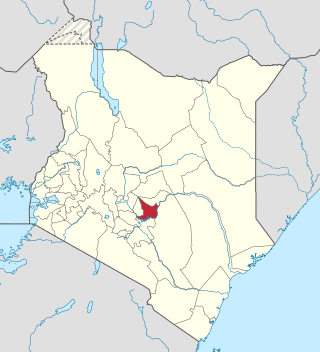Kiambere | |
|---|---|
| Country | Kenya |
| Province | Eastern Province |
| Time zone | UTC+3 (EAT) |
Kiambere is a settlement in Kenya's Eastern Province. The Kiambere Dam is located nearby.
Kiambere | |
|---|---|
| Country | Kenya |
| Province | Eastern Province |
| Time zone | UTC+3 (EAT) |
Kiambere is a settlement in Kenya's Eastern Province. The Kiambere Dam is located nearby.
Nicholas Kipyator Kiprono arap Biwott was a Kenyan businessman, politician, and philanthropist. Biwott served as a civil servant, Member of Parliament and government minister, during which time he held eight senior ministerial positions during the presidency of Daniel arap Moi.

Embu County is a county of Kenya. The capital of Embu County and the former Eastern province headquarters, Embu is a large and largely metropolitan area with a population of 608,599 persons. The county borders Kirinyaga to the west, Kitui to the east, Tharaka Nithi to the north and Machakos to the south. The county occupies an area of 2,821 km2.

Mbeere District was a former administrative district in the Eastern Province of Kenya. Its capital town was Siakago. The district had a population of 170,950 and an area of 2,093 km2. The district was split from Embu District in 1996. In 2010, it was merged into Embu County.

Kenya Electricity Generating Company PLC abbreviated to KenGen, is a government enterprise in the Republic of Kenya charged with the production of electricity for the country. KenGen is the largest electric power producer in Kenya, generating over 60% of the electricity consumed in the country.
The Kiambere Hydroelectric Power Station is an earth-filled embankment dam on the Tana River near Kiambere, Kenya. It straddles the border of Embu and Kitui Counties in the former Eastern Province. The primary purpose of the dam is hydroelectric power generation and it supports a 165 MW power station. Construction on the dam began in 1983 and it was completed in 1987. The power station was commissioned in 1988. Beginning in 2008 both turbine-generators were upgraded from 72 MW to 82.5 MW. They were commissioned in 2009. US$95 million in funding for the original project was provided by the World Bank. The power station is operated by Kenya Electricity Generating Company and is part of the Seven Forks Scheme.

Water supply and sanitation in Kenya is characterised by low levels of access to water and sanitation, in particular in urban slums and in rural areas, as well as poor service quality in the form of intermittent water supply. Seasonal and regional water scarcity in Kenya exacerbates the difficulty to improve water supply.
The Kindaruma Hydroelectric Power Station, also Kindaruma Dam is an embankment dam with two gravity dam sections on the Tana River in Kenya. It straddles the border of Embu and Machakos counties in Kenya. The primary purpose of the dam is hydroelectric power generation and it supports a 72 megawatts (97,000 hp) power station. It is Kenya's first post-independence hydroelectric power plant. It was commissioned in 1968 as part of the Seven Forks Scheme. The power station is operated by Kenya Electricity Generating Company.

Kenya–Saudi Arabia relations are bilateral relations between Kenya and Saudi Arabia.
Masinga Hydroelectric Power Station, also Masinga Dam, is an embankment dam on the Tana River, the longest river in Kenya and straddles the border of Embu and Machakos Counties in Eastern Province and is located about 106 km. (66 mi.), by road, northeast of Nairobi, Kenya's capital and largest city. Construction of the dam began in 1978, and was completed in 1981. It is owned by Tana and Athi Rivers Development Authority (TARDA). The dam is used for power production and is part of the Seven Forks Scheme.
Karura Hydroelectric Power Station, commonly referred to as Karura Power Station, also Karura Dam, is a planned 90 MW hydropower station in Kenya.

The presidency of Mwai Kibaki began at 11:00 AM GMT on Monday 30 December 2002, when Mwai Kibaki was inaugurated as the 3rd president of Kenya and ended on 9 April 2013 when he handed over to Uhuru Kenyatta. A NARC candidate, Kibaki was a businessman and member of parliament of Othaya constituency prior to his 2002 election victory over KANU nominee Uhuru Kenyatta.